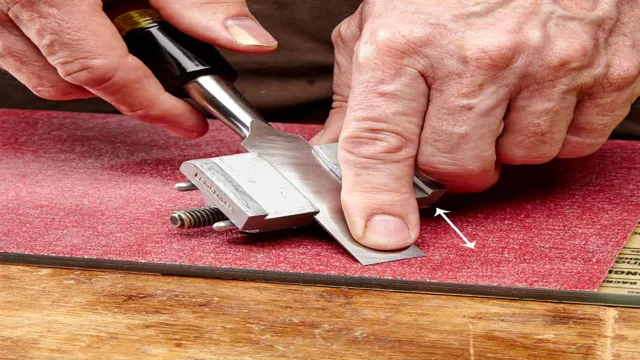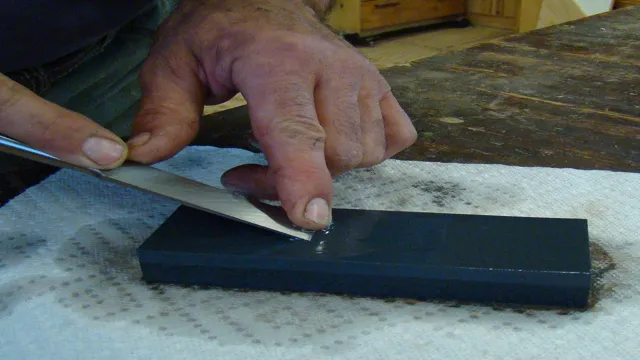If you’re considering taking on any woodworking project, having the right tools is crucial. And when it comes to chisels, the sharpening angle is one of the most important things to get right. Choosing the correct sharpening angle for your chisels can make all the difference in the quality of your work.
A poorly sharpened chisel can make even the most basic woodworking task difficult. In this blog, we’ll take a closer look at the correct angle for sharpening your chisels, so you can get the best results every time.
What is the Ideal Angle?
“What angle do you sharpen chisels at?” is a common question among woodworkers and DIY enthusiasts. The ideal angle largely depends on the type of chisel you have and the task it is used for. For instance, a bevel-edged chisel meant for rough work may be sharpened at an angle of around 25°-30°, while a firmer-edged chisel used for more precise work may be sharpened at an angle of around 30°-35°.
It’s also important to note that the angle may vary depending on personal preferences and the type of wood being worked on. Experimenting with different angles is the best way to find the ideal one for your chisel. Sharpening a chisel at an appropriate angle helps to maintain its sharpness for longer and improves the quality of the work done with it.
So, invest some time to find the perfect angle for your chisels, and your woodworking projects will turn out great!
Understanding Chisel Bevel Angles
Chisel bevel angles play an essential role in the performance of a chisel. An ideal bevel angle is crucial as it affects the chisel’s sharpness, durability, and performance. Chisels come in various bevel angles, ranging from steep to shallow angles.
The ideal angle for chisels depends on their intended use and the type of wood being carved. Generally, a 25-degree bevel angle is considered ideal for most chisels. However, for more delicate woodwork, a 20-degree angle may be more suitable, while for heavier woodworking, 30 degrees or more might be better.
Ultimately, the bevel angle determines the edge’s sharpness, wear resistance, and the amount of force needed to make a cutting action. Therefore, it’s essential to select the right bevel angle to ensure a clean and precise cut with minimal effort.

Different Types of Chisels and Their Angles
When it comes to using chisels, understanding the different types and angles can make all the difference in the final outcome of your project. The ideal angle for a chisel will depend on the type of chisel being used and the material it’s being used on. For example, a beveled edge chisel is typically used for rough work and can have an angle of 25-30 degrees, while a paring chisel used for delicate work may have an angle of 20-25 degrees.
Additionally, skewed chisels have a unique angle that allows for easier carving and shaping of intricate details. It’s important to remember that while a specific angle may be recommended, it’s ultimately up to personal preference and experience. Finding the ideal angle may require some experimentation and tweaking to achieve the desired results.
In the end, the goal is to have a sharp and durable chisel that can handle anything you throw at it.
Getting the Perfect Angle
When it comes to sharpening your chisels, the angle you choose is crucial to achieving the perfect edge. The ideal angle for sharpening chisels typically ranges from 25 to 35 degrees, depending on the type of wood you will be working on and the type of chisel you are sharpening. For instance, if you are working on softer woods, such as pine or spruce, you should sharpen at a steeper angle, around 30 degrees.
On the other hand, for harder woods like oak or maple, a shallower angle of around 25 degrees will work better. It’s always important to keep in mind that the sharper the angle, the sharper the edge, but also the more delicate the chisel becomes. Therefore, the best approach is finding the perfect balance between sharpness and durability so that you can get the most out of your sharpening efforts.
Tools Required for Sharpening Chisels
When it comes to sharpening chisels, having the right tools is crucial in achieving the perfect angle. One essential tool for sharpening chisels is a honing guide, which helps you maintain a consistent angle while sharpening. Another useful tool is a sharpening stone, which comes in a variety of grits to help you achieve a razor-sharp edge.
Additionally, a strop and honing compound can be used to refine and polish the edge of the chisel further. When using these tools, it’s important to take your time and go slow, as rushing can lead to mistakes and uneven sharpening. With patience and the right tools, you can achieve a razor-sharp edge on your chisels every time.
Step-by-Step Guide to Sharpening Chisels
When it comes to sharpening chisels, getting the perfect angle is essential for achieving a sharp edge that will last. The first step is determining the bevel angle, which is the angle at which the blade is sharpened. Most chisels have a bevel angle between 25 and 30 degrees, but it can vary depending on the type of chisel and the intended use.
Once you have determined the bevel angle, you can use a honing guide to ensure that the blade is sharpened at the correct angle. Consistency is important when sharpening chisels, so be sure to maintain the same angle throughout the sharpening process. With practice, you can develop a feel for the correct angle and achieve a sharp edge every time.
Remember, the key to getting the perfect angle is patience and practice.
Tips and Tricks for Maintaining the Correct Angle
When it comes to maintaining the correct angle, there are a few tips and tricks that can help you get the perfect shot every time. First, make sure that your stance is solid and balanced, with your feet shoulder-width apart and your knees slightly bent. This will help you stay steady and avoid any unnecessary movement.
Additionally, it’s important to keep your arms and hands relaxed, allowing for a smooth and natural motion. Another useful tip is to focus on your breathing, taking deep and steady breaths to help you stay calm and centered. Finally, don’t forget to practice regularly to develop your technique and build up your muscle memory.
With these simple strategies, you’ll be able to maintain the correct angle and capture stunning photos with ease.
Common Mistakes to Avoid
When it comes to sharpening chisels, one of the most common mistakes is setting the wrong angle on the sharpening stone. Many people believe that a steeper angle will yield a sharper edge, but this is not always the case. In fact, using too steep of an angle can actually cause the chisel to lose its sharpness more quickly, as well as increase the risk of damaging the blade.
The ideal angle for sharpening chisels typically ranges between 25 and 30 degrees, though this can vary depending on the specific type of chisel and the job at hand. By using the correct angle and taking care not to overuse the blade, you can keep your chisels sharp and effective for years to come.
Over-Grinding and Under-Grinding
Over-grinding and under-grinding are two common mistakes that many people make when using grinders. Over-grinding can result in burnt or bitter-tasting coffee, while under-grinding can lead to weak or sour-tasting coffee. These mistakes can be easily avoided by paying attention to the grind size and adjusting the grinder accordingly.
Remember, different brewing methods require different grind sizes, so it’s important to know which grind size is appropriate for your brewing method. If you find yourself making these mistakes, don’t worry! It takes practice to develop the skill of grinding coffee beans, but with patience and persistence, you’ll be able to master the art of coffee grinding. So, take the time to learn how to properly adjust your grinder, and you’ll be rewarded with a delicious cup of coffee every time.
Ignoring the Primary Bevel Angle
One of the most common mistakes when working with tools such as chisels and hand planes is ignoring the primary bevel angle. Many craftsmen and DIY enthusiasts often overlook the importance of this aspect of the tool, which can greatly affect the outcome of their work. The primary bevel angle is the angle between the blade’s edge and the flat surface of the tool.
This angle controls how the blade slices through the wood and how much pressure it exerts. Ignoring this angle can result in an uneven cut, splintering, or even damage to the tool. It’s important to research and understand the correct angle for your specific tool and materials, as well as regularly checking and maintaining this angle to ensure consistent and efficient cutting.
By paying attention to the primary bevel angle, you can improve the quality of your work and extend the lifespan of your tools.
Conclusion
In the end, the angle at which you sharpen your chisels may seem like a trivial matter, but it can make all the difference in the quality of your work. Too steep of an angle and your chisel will be too fragile and prone to breakage, while too shallow of an angle will result in a dull and ineffective tool. So, whether you choose a 25, 30, or 35-degree angle, it’s important to sharpen your chisels with precision and care, because as they say, a sharp chisel is a woodworker’s best friend.
“
FAQs
What is the best angle to sharpen chisels at?
The best angle to sharpen chisels at is typically between 25 and 30 degrees.
Can you sharpen chisels with a bench grinder?
Yes, you can sharpen chisels with a bench grinder, but it requires skill and caution to avoid causing damage.
What is the difference between honing and sharpening a chisel?
Honing a chisel involves polishing the edge to refine its sharpness, while sharpening a chisel involves removing material to create a new edge.
How often should you sharpen your chisels?
The frequency of chisel sharpening depends on the frequency and intensity of use. A good rule of thumb is to sharpen them when you notice the edge becoming dull.
What is the proper technique for sharpening a chisel?
The proper technique for sharpening a chisel involves holding the blade at the correct angle, using a honing guide if necessary, and sharpening the blade with a sharpening stone or other appropriate tool.
What should you avoid when sharpening chisels?
When sharpening chisels, you should avoid creating an uneven edge, applying too much pressure, overheating the blade, and using the wrong type of sharpening tool.
Can you use a honing guide to sharpen chisels?
Yes, a honing guide can be beneficial when sharpening chisels, as it helps to maintain the correct sharpening angle and prevents uneven edges.





